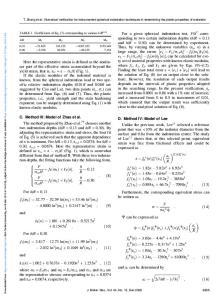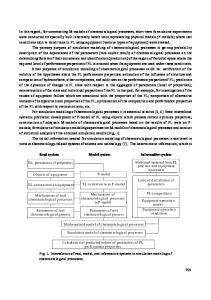A hybrid method for determining material properties from instrumented micro-indentation experiments
- PDF / 1,148,415 Bytes
- 8 Pages / 576 x 792 pts Page_size
- 25 Downloads / 342 Views
A. W. Ruff National Institute of Standards and Technology, Gaithersburg, Maryland 20899
J. W. Dally Mechanical Engineering Department, University of Maryland, College Park, Maryland 20742 (Received 13 September 1993; accepted 7 January 1994)
The impact code EPIC was employed to study the relationship between the applied force and the penetration depth in a micrometer-scale indentation experiment with oxygen free high conductivity (OFHC) copper. EPIC is an elastic-plastic finite element code that uses a Lagrangian formulation and triangular mesh, which can accommodate large deformation without the need to remesh during the computation process. By fitting the force-penetration curves for a triangular indenter with second degree polynomials, it was demonstrated that the fit changed with two material constants in the constitutive equation. A systematic procedure for determining the material constants is described that is based on matching either the slope or the curvature of the force penetration depth curves from numerical simulation and experiments. It is concluded that material constants can be determined from indentation data obtained using pyramidal or spherical indenters as well as a flat-ended indenter.
I. INTRODUCTION The use of indentation methods to measure material hardness has in recent years been extended to loads of 10 mN and below to examine materials with fine scale microstructure or material with modified surfaces.1^1 Such nanoindentations, involving depths of the order of 10-100 nm, usually give hardness results that differ significantly from more macroscopic indentation tests. Possible reasons for these differences include the effect of size scale on plastic and fracture response of materials, and the role of surface energy or other nearsurface effects. It is important to understand thoroughly the deformation fields associated with indentation, so that nanoindentation testing can lead to a mechanical property measurement that can be compared with more conventional results. Over the past 20 years nonlinear analytical and finite element techniques have been developed to solve indentation problems involving elastic-plastic deformation.5"13 Analytical methods are difficult to implement because of the complex nonlinear constitutive relation. Hardy et al? and Lee et al.8 performed elastic-plastic finite element solutions for ball indentation in the early 1970s; however, due to computational difficulties, the maximum load was limited. More recently this problem was examined again by Follansbee and Sinclair9 with the inclusion of incremental elastoplasticity and work hardening in the constitutive equation. They showed that with 1314
J. Mater. Res., Vol. 9, No. 5, May 1994
http://journals.cambridge.org
Downloaded: 06 Apr 2015
increasing plasticity the contours for the pressure distribution change from an elliptical shape to a flat shape. Since the numerical techniques require significant programming time, commercial finite element packages have become popular in solving contact problems. Komvopoulos10
Data Loading...











